
The County of Toulouse was a territory in southern France consisting of the city of Toulouse and its environs, ruled by the Count of Toulouse from the late 9th century until the late 13th century.
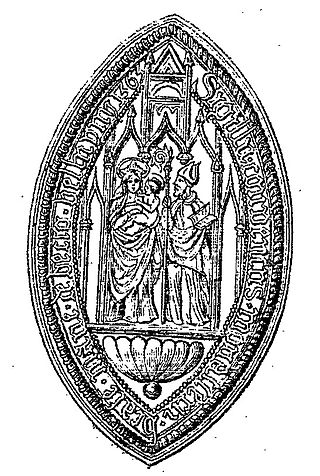
Bec Abbey, formally the Abbey of Our Lady of Bec, is a Benedictine monastic foundation in the Eure département, in the Bec valley midway between the cities of Rouen and Bernay. It is located in Le Bec Hellouin, Normandy, France, and was the most influential abbey of the 12th-century Anglo-Norman kingdom.

Corbie Abbey is a former Benedictine monastery in Corbie, Picardy, France, dedicated to Saint Peter. It was founded by Balthild, the widow of Clovis II, who had monks sent from Luxeuil. The Abbey of Corbie became celebrated both for its library and the scriptorium.
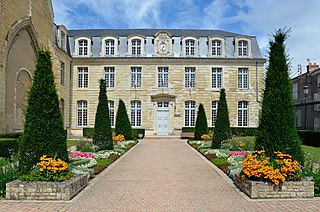
Thouars is a commune in the Deux-Sèvres department in western France. On 1 January 2019, the former communes Mauzé-Thouarsais, Missé and Sainte-Radegonde were merged into Thouars.

Fontenelle Abbey or the Abbey of St. Wandrille is a Benedictine monastery in the commune of Rives-en-Seine. It was founded in 649 near Caudebec-en-Caux in Seine-Maritime, Normandy, France.
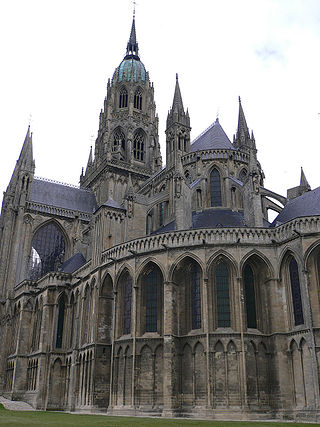
The Diocese of Bayeux and Lisieux is a Latin Church diocese of the Catholic Church in France. It is coextensive with the Department of Calvados and is a suffragan to the Archdiocese of Rouen, which is also in Normandy.

The Diocese of Angoulême is a Latin diocese of the Catholic Church in France. Originally erected in the 3rd century, the episcopal see is the Angoulême Cathedral. Comprising the département of the Charente, the diocese had traditionally been suffragan to the Archbishopric of Bordeaux, under the old régime as well as under the Concordat, but since 2002 is suffragan to the Archdiocese of Poitiers.

The Diocese of Périgueux and Sarlat is a Latin Church ecclesiastical territory or diocese of the Catholic Church in France. Its episcopal see is Périgueux, in the département of Dordogne, in the région of Aquitaine. The Diocese of Périgueux is a suffragan diocese in the ecclesiastical province of the metropolitan Archdiocese of Bordeaux. The current bishop is Philippe Mousset, who was appointed in 2014.

The Ramnulfids, or the House of Poitiers, were a French dynasty of Frankish origin ruling the County of Poitou and Duchy of Aquitaine in the 9th through 12th centuries. Their power base shifted from Toulouse to Poitou. In the early 10th century, they contested the dominance of northern Aquitaine and the ducal title to the whole with the House of Auvergne. In 1032, they inherited the Duchy of Gascony, thus uniting it with Aquitaine. By the end of the 11th century, they were the dominant power in the southwestern third of France. The founder of the family was Ramnulf I, who became count in 835.

Mozac Abbey is a former Cluniac monastery in the commune of Mozac near Riom in Auvergne, France.

The former Catholic diocese of Maillezais in north-west France was erected in 1317, by Pope John XXII, and ceased to exist in 1648 when it was incorporated into the new diocese of La Rochelle. The town of Maillezais is now found in the department of Vendée, and most of the territory of the former diocese belongs to the diocese of Luçon.

Maillezais Cathedral is a ruined Roman Catholic church in the commune of Maillezais in the Vendée, France. Formerly the site of the Abbey of Saint-Pierre, the site grew from the 10th century abbey to the cathedral completed in the 15th century, with the many structures at the site abandoned by the end of the 17th century. Today's ruins consist of a cathedral, refectory, dormitory, kitchen, cellars, turrets and ramparts. The cathedral has been declared a heritage monument in reflection of its Romanesque and Gothic architectural form. It was designated a monument historique on 30 January 1924. The cathedral belonged to the Diocese of Luçon, with Roman Rites, and with St. Peter as the patron saint.

The Diocese of Nîmes is a Latin diocese of the Catholic Church in France. The diocese comprises all of the department of Gard. It is a suffragan of the Diocese of Avignon.
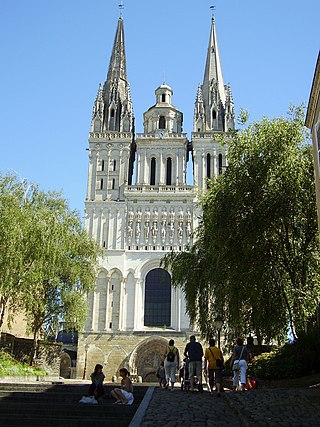
The Diocese of Angers is a Latin Church diocese of the Catholic Church in France. The episcopal see is located in Angers Cathedral in the city of Angers. The diocese extends over the entire department of Maine-et-Loire.

Mondaye Abbey is a French Premonstratensian abbey in the Bessin countryside at Juaye-Mondaye, Calvados, nine miles to the south of Bayeux. Founded in 1200, it is the only Premonstratensian house still active in Normandy, with two dependent priories at Conques and Tarbes.
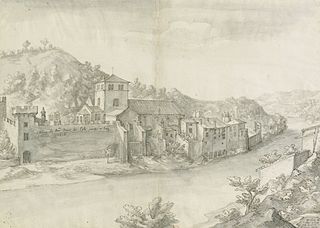
The Abbey of Île Barbe was an Abbey built very early in the Christian era, on Île Barbe, outside of Lyon, France.

Cerisy Abbey, otherwise the Abbey of Saint Vigor, located in Cerisy-la-Forêt, Manche, France, was an important Benedictine monastery of Normandy.
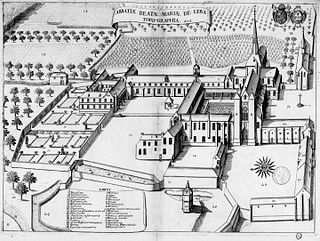
Lyre Abbey was a monastery in Normandy, founded in 1046 at what is now the village of La Vieille-Lyre. From the mid-12th century it was a Benedictine house. It was abolished at the French Revolution and the abbey buildings mostly destroyed.

Buzay Abbey, dedicated to Our Lady, was a Cistercian Abbey at Rouans in Pays de la Loire, France, formerly in Brittany, founded in 1135 and dissolved in 1790.



















